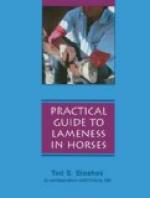Before there is evidence of an exostosis, diagnosis of ringbone is not easy, for it is then a problem of detecting the presence of a ligamentous sprain, periostitis, or osteitis. The diagnostician should take note of local manifestations of hypersensitiveness, or heat if such exist, and, in addition, other conditions must be excluded before definite conclusions are possible.
In articular ringbone as soon as there is developed an exostosis, it occupies a position on the dorsal (anterior) part of the articulation and extends around the sides of the joint.
Periarticular ringbone is characterized by exostoses which are situated on the sides of the phalanges and not extending around to the anterior part of the joint. This type of ringbone as well as the articular may occur “high” or “low.”
[Illustration: Fig. 19—Phalangeal exostoses in chronic ringbone. Museum specimen of the Kansas City Veterinary College.]
With the traumatic form of ringbone, all consequences, as to the size and form the exostosis is to assume, depend upon the nature and extent of the injury.
Rachitic ringbone is frequently observed in some sections of the country and does not ordinarily cause much if any lameness. It is a disease of colts and may affect one or all of the phalanges at the same time. As the subject advances in age there is more or less diminution in the size of the enlargements.
Treatment.—Rest is essential in the treatment of ringbone. If diagnosed during its incipiency, remedial measures such as are usually employed to treat sprains, are indicated and later the parts should be blistered. When an exostosis has developed puncture firing is the remedy par excellence. Not that this method of treatment is infallible, for to any thinking one who takes into consideration the pathological anatomy of this condition, it is evident that no manner of treatment is beneficial in some cases. If the exostosis is so situated that it does not mechanically interfere with function, and is not so large that it may inhibit flexion and extension, and where the articular portions of the joint are not eroded, good results attend the use of the actual cautery.
In firing, after having anesthetized the extremity, and prepared the surgical area, the cautery is deeply inserted in numerous places, taking care, however, not to open the joint. The parts are immediately covered with aseptic absorbent cotton and this dressing is left in position for forty-eight hours and if perchance there is evidence of synovial discharge, the parts are again aseptically dressed in order to prevent infection of the articulation. If, as is the case usually, no perforation of the joint capsule exists, the openings made by the cautery have been closed by the coagulation of serum and there is then little chance of infection causing trouble, even though the member is left unbandaged.




